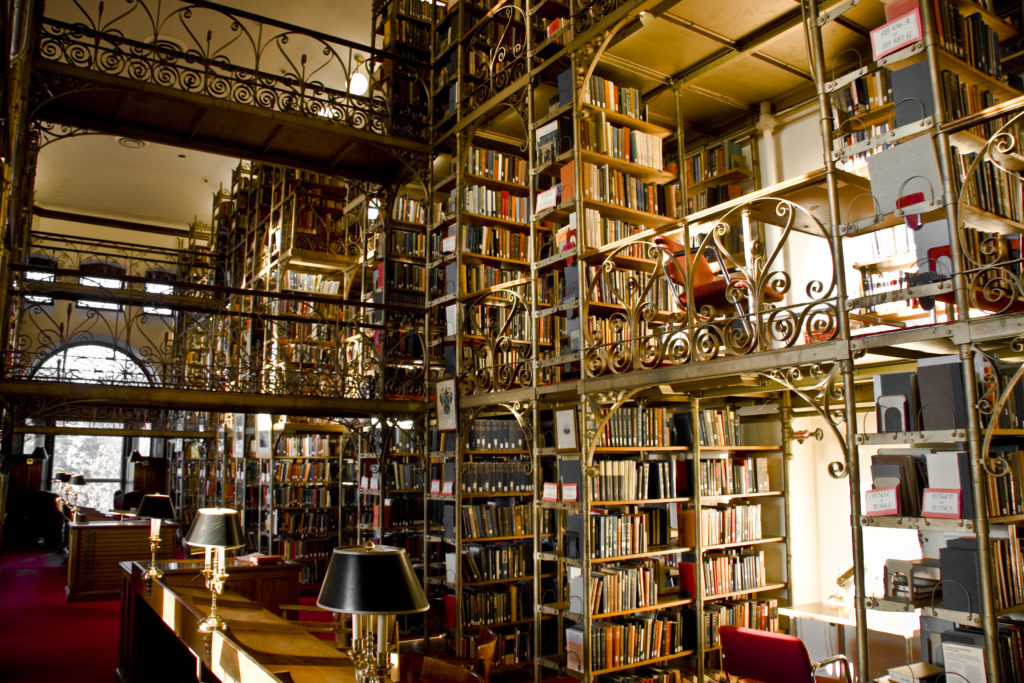See the full symposium on Adam Bloom here.
The third part of Allan Bloom’s masterwork, The Closing of the American Mind, is devoted to the state of the American university. It deserves special attention, and not just because it is usually ignored. In reading it, those of us who lived through the period it describes will be forced to relive and rethink a bygone era of very great importance for the evolution of higher education in America. Those too young to remember the events that Bloom mentions will discover the antecedents for today’s suppression of public debate concerning the fundamental human questions: who we are and how we should live our lives. We are now reaping the harvest that was sown half a century ago.
To a considerable degree, this part of Bloom’s book is autobiographical, a meditation on the crisis that engulfed Cornell University in April 1969. At the time, Bloom was an associate professor in the Department of Government. His translation of Plato’s Republic had been published late the previous fall, and he was busy teaching a year-long seminar on the book, initially using mimeographs of his translation. As it happens, I was enrolled in that seminar, and the events that took place at Cornell that spring were as seminal for me as they were for Bloom.
I was then in my second year at Cornell and very active on campus. Until late March of 1969, I served on the appeals court of the university student conduct tribunal. I wrote a column for The Cornell Daily Sun, and at the end of the spring vacation I became associate editor of the paper. Because I was a member of the appeals court, I saw the last stage of the crisis, which ostensibly turned on the legitimacy of the judicial system, coming nine months before nearly everyone else. I wrote an account at the time—initially commissioned by The Cornell Alumni Magazine but judged too hot for that journal to publish—which was privately printed and circulated at the time and may soon be available online. Donald Downs, who was at Cornell at the time, later published a book on the subject.
Start your day with Public Discourse
Sign up and get our daily essays sent straight to your inbox.What Happened at Cornell: The Preliminaries
To understand the events described below, one should be aware that Cornell was the first major university to seek out actively and recruit black students whose college boards scores fell dramatically below those normally required for entrance. In the fall of 1967, a group of these students, enraged at the remarks of a visiting economics professor, poured into the department office, held the chairman captive for seven hours, and roughed up campus patrolmen and Sun reporters who appeared on the scene. An investigation of the professor’s conduct was promised, no one was punished for misconduct, and the visiting professor soon departed.
A year later, on December 6, 1968, a group of fifty black students associated with the Afro-American Society (AAS) forced their way into a meeting of the program committee for the fledgling Afro-American Studies Program. They claimed control over the program, demanding that no whites remain on the committee. On that same day, six black students invaded a university building and evicted the three whites who had offices there. In the process, a Sun reporter was beaten. On the following Sunday, seven black students, brandishing realistic-looking toy guns, stopped traffic on campus and intimidated passersby. Four days thereafter, Cornell President James Perkins agreed to establish a racially segregated Afro-American Studies Program with a black director and a great degree of autonomy and to set aside separate dining facilities for black students.
Two months after these incidents, in the last week of February 1969, members of the AAS disrupted a speech given by a supporter of apartheid at a symposium on South Africa. Others armed with two-by-fours interrupted President Perkins’s introduction of Congressman Allard Lowenstein, demanding that he first answer questions concerning the university’s investment policy.
Two weeks later, on March 10, three alumni recruiting employees for Chase Manhattan Bank were driven from the campus by a violent demonstration involving AAS members. On March 13, when the student conduct tribunal met to engage in a preliminary discussion of the so-called “toy-gun spree,” 150 AAS members massed outside the room in an attempt to intimidate its members. In early April, the administration placed the new Center for Afro-American Studies under the effective control of a board of ten scholars chosen from a list of fifteen nominated by the AAS.
Such were the preliminaries. Then came the storm.
The Storm
At dawn on April 18, 1969—the Saturday of Parents’ Weekend and the day after the student conduct tribunal issued a reprimand (as minor a penalty as was available) to those who had engaged in the “toy-gun spree”—a group of black students, brandishing crowbars, seized control of the student union (Willard Straight Hall), rudely awakened parents sleeping in the guest rooms upstairs, used the crowbars to force open the doors, and ejected them from the union.
Later that day, they brought at least one rifle with a telescopic sight into the building. On Sunday afternoon, the administration agreed to press neither civil nor criminal charges and not to take any other measures to punish those who had occupied Willard Straight Hall, to provide legal assistance to anyone who faced civil charges arising from the occupation, and to recommend that the faculty vote to nullify the reprimands issued to those who had engaged in the “toy-gun spree.” Upon hearing that this agreement had been reached, 110 black students marched out of Willard Straight Hall in military formation to celebrate their victory, carrying more than seventeen rifles and bands of ammunition.
The next day, when the faculty balked and stopped short of accepting the administration’s recommendation, one AAS leader went on the campus radio and threatened to “deal with” three political science professors and three administrators, whom he singled out by name, “as we will deal with all racists.” Finally, on Wednesday, April 23, the faculty met at a special meeting and capitulated to the demands of the AAS, rescinding the reprimand issued by the student conduct tribunal and calling for a restructuring of the university.
Bloom was among the stalwarts who fought to stiffen the faculty’s resolve, as were his fellow political scientists Allan Sindler (who had played a prominent role as a strategist in the civil rights movement) and Walter Berns. The latter two were among those singled out by name over the radio, and they responded to the capitulation of the faculty by resigning their professorships on national television. Berns, who was Bloom’s close friend, prevented him from immediately following suit. Eventually, however, Bloom too left Cornell for the University of Toronto. As for me, after denouncing what had been done in the pages of The Cornell Daily Sun and successfully working with others to get Perkins fired from his post as president of the university, I transferred to Yale.
These events—above all, the astonishing display of cowardice and fecklessness by the faculty in the face of a movement that openly threatened academic freedom—form the backdrop to Bloom’s ruminations on the American university. It was in this light that he considered the trajectory of philosophy from Socrates to Martin Heidegger—whose Rektoratsrede, an address delivered at the University of Freiburg in 1933, he singles out for close examination. Bloom believed that the intellectual ethos that had led to the collapse of the German university in the face of National Socialism had since come to dominate and undermine the American university.
There is nothing that has happened in American higher education in the last few years that would have surprised Bloom. The demand for “trigger warnings” and “safe spaces,” the offense taken at so-called “micro-aggressions,” and the resort to violence are a parody of the rougher stuff that happened in Germany in the mid-1930s. Bloom believed that the cowardice displayed by university administrations and faculties in the face of thuggery back in the late 1960s portended an end for the life of the mind in the United States. Recent events at Yale University, the University of Missouri, Claremont McKenna College, the University of California at Berkeley, Middlebury College, and elsewhere suggest that he was right. On most campuses, the most important questions can no longer be posed, and students, as well as faculty members, engage in self-censorship.
The Tyranny of the Majority and the Power of Liberal Education
In the first section of the first chapter in the part of his book devoted to the university, Bloom turns to Tocqueville’s Democracy in America—from which he gleans the premise of his argument: that there is a profound tension between liberal democracy and the life of the mind. If, he intimates, there is a closing of the American mind, it is, as Tocqueville indicated, because in democratic ages equality is the norm. When no individuals or groups really stand out, the only authority is popular opinion, and, without pausing to reflect on what they are doing, human beings tend to follow its lead.
Tocqueville’s tyranny of the majority is gentle. It does not require violence, for its reign is psychological. Those who do not surrender to the temper of the times tend to be shunned. Those who do not go along tend not to get along.
In Bloom’s view, the only thing that stands in the way of this species of tyranny is liberal education. At the best universities, young people—at an age when the most intelligent are filled with an erotic longing for the beautiful and the good—are exposed to what Matthew Arnold called “lost causes and forsaken beliefs.” When, at the age of fifteen, Bloom journeyed from Indianapolis to the University of Chicago, he found this oasis of learning profoundly liberating. He was exposed to Plato, Shakespeare, Jonathan Swift, Rousseau, Nietzsche, and other great authors in an environment where their greatness was taken for granted and one was expected to pore over them, comparing their arguments with one another and considering whether and to what degree what each had to say was true. This opened up new horizons and enabled him to confront the larger world with a puzzled and critical eye.
In Bloom’s opinion, liberal education—an education that liberates students from an enslavement to reigning public opinion by awakening them from dogmatic slumber—is a boon for liberal democracy. It promotes an open-mindedness and a detached perspective on present political struggles that is essential to the proper exercise of citizenship. As he puts it, “the successful university is proof that a society can be devoted to the well-being of all, without stunting human potential or imprisoning the mind to the goals of the regime.” It is “an unpopular institution in our midst that sets clarity above well-being or compassion, that resists our powerful urges and temptations, that is free of all snobbism but has standards.”
Although it is frequently interpreted as a political polemic, Bloom’s book is actually a call for a return to Socratic rationalism. For it is only on the premise that reason might be able to provide us with guidance regarding the good life that liberal education is defensible.














